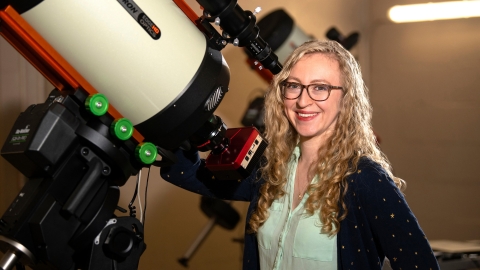
Bucknell Professor Makes Celestial Discovery from 12 Light-years Away
April 3, 2023
Professor Jackie Villadsen studies the magnetic field interactions between distant stars and their orbiting planets. Photo by Emily Paine, Communications
One of astronomy's burning mysteries is whether another Earth-like planet exists in far off stars. Bucknell University Professor Jackie Villadsen, physics & astronomy, is now contributing evidence that suggests there may be — at least when it comes to the Earth's magnetic field. She is co-author of a paper documenting bursts of radio waves from the red dwarf star YZ Ceti, which is 12 light-years away. The star has a planet, YZ Ceti b, orbiting very close to it, and the brightness of the radio waves suggests this planet may have a magnetic field similar to Earth's.
Villadsen and co-author J. Sebastian Pineda, a research astrophysicist at the University of Colorado Boulder, observed a repeating radio signal emanating from YZ Ceti using the Very Large Array, a radio telescope operated by the U.S. National Science Foundation's (NSF) National Radio Astronomy Observatory (NRAO). Both Pineda and Villadsen are supported by NSF to understand the magnetic field interactions between distant stars and their orbiting planets. Their research was published today in the journal Nature Astronomy.

An artist's conceptual rendering of interactions between an exoplanet and its star. Plasma emitted from the star is deflected by the exoplanet's magnetic field. That interaction perturbs the star's magnetic field and generates auroras on the star and radio waves. Art by Alice Kitterman/National Science Foundation
Earth's magnetic field has helped to play a significant role in protecting the planet's atmosphere, which sustains life. The detection of radio waves from YZ Ceti could be a sign that its orbiting planet's magnetic field is interacting with the star — meaning the planet's magnetic field is possibly like Earth's, according to Villadsen.
"Planet magnetic fields are the 'force fields' that protect the planets from losing all of their air, so finding ways to detect these force fields is pretty exciting," she says. "If we are correct and the planet is causing these radio waves from its host star, it may have a magnetic field similar to Earth's."
This research was conducted using NRAO's state-of-the-art radio telescope array, the Karl G. Jansky Very Large Array. Data was collected from YZ Ceti and its system of terrestrial planets during a 25-hour period.
In their paper, the researchers document 2- to 4-gigahertz detections of radio bursts on the slowly rotating YZ Ceti during the orbital period of YZ Ceti b, the innermost planet in the system. Two coherent bursts occur at similar orbital positions of YZ Ceti b, suggesting an enhanced probability of magnetic interaction between the planet and star.
"We looked at this star for about 25 hours, which is less than one full orbit, but we had about a third of the original orbit, and then we followed up at the same place where we saw a radio burst before," Villadsen says. "Then we saw a second radio burst that was close to the same planetary position, but not exactly the same. That's promising for star-planet interaction. What's needed long term is to follow this thing up and look over and over again and see if the bursts always happen when the planet is near this position in its orbit."
The planet's close proximity is important because it needs to be close to potentially send energy back to the star.
"I think a good conclusion is if we are correct that the planet is causing these bursts of radio waves, it implies that the planet has a magnetic field similar or even a little stronger than Earth's," Villadsen says. "What that would say is Earth's magnetic field isn't unusual and not an anomaly."
Villadsen, Pineda and Bucknell physics student Arjun Anand '25 plan to continue studying the radio bursts between stars and their orbiting planets during a summer research trip at NRAO.
"To lock down planets that are definitely known to be causing bursts of radio waves from the star, we're going to require a pretty long monitoring program," Villadsen says. "We need to point [the array] at that star regularly for a long time to know if these radio wave bursts are really repeating with a planet. What we have identified is a system [YZ Ceti] that's really worth putting in that time and monitoring it long term."

